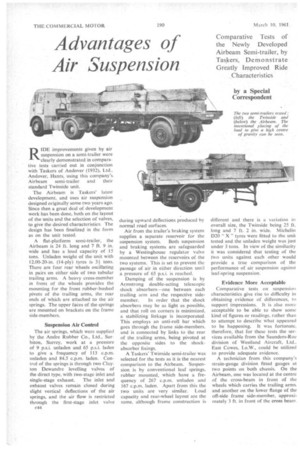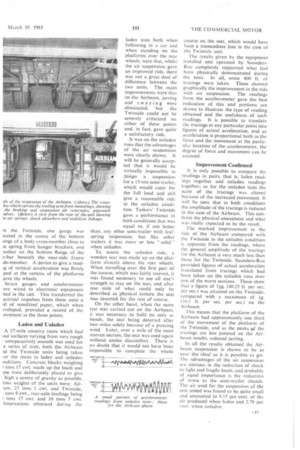Advantages of Air Suspension
Page 82

Page 83

If you've noticed an error in this article please click here to report it so we can fix it.
RIDE improvements given by air suspension on a semi-trailer were clearly demonstrated in comparative tests carried out in conjunction with Taskers of Andover (1932), Ltd., Andover, Hants, using this company's Airbeam semi-trailer and their standard Twinside unit.
The Airbeam is Taskers' latest development, and uses air suspension designed originally some two years ago. Since then a great.deal of development work has been done, both on the layout of the units and the selection of valves, to give the desired characteristics. The design has been finalized in the form as on the unit tested.
A flat-platform semi-trailer, the Airbeam is 24 ft. long and 7 ft. 9 in. wide and has a load capacity of 15 tons. Unladen weight of the unit with 12.00-20-in. (14-ply) tyres is 31 tons. There are four rear wheels oscillating in pairs on either side of two tubular trailing arms. A heavy cross-member in front of the wheels provides the mounting for the front rubber-bushed pivots of the trailing arms, the rear ends of which are attached to the air springs. The upper faces of the springs are mounted on brackets on the frame side-members.
Suspension Air Control
The air springs, which were supplied by the Andre Rubber Co., Ltd., Surbiton, Surrey, work at a pressure of 9 p.s.i. unladen and 65 p.s.i. laden to give a frequency of 113 c.p.m. unladen and 84.5 c.p.m. laden. Control of the springs is through two Clayton Dewandre levelling valves of the direct type, with two-stage inlet and
single-stage exhaust. The inlet and exhaust valves remain closed during slight vertical deflections of the air springs, and the air flow is restricted through the first-stage inlet valve
c44 during upward deflections produced by normal road surfaces.
Air from the trailer's braking system supplies a separate reservoir for the suspension system. Both suspension and braking systems are safeguarded by a Westinghouse regulator valve mounted between the reservoirs of the two systems. This is set to prevent the passage of air in either direction until a pressure of 65 p.s.i. is reached.
Damping of the suspension is by Armstrong double-acting telescopic shock absorbers—one between each trailing arm and the respective side member. In order that the shock absorbers may be as light as possible, and that roll on corners is minimized, a stabilizing linkage is incorporated. This employs an anti-roll bar which goes through the frame side-members. and is connected by links to the rear of the trailing arms, being pivoted at the opposite sides to the shockabsorber fixings.
A Taskers' Twinside semi-trailer was selected for the tests as it is the nearest comparison to the Airbeam. Suspension is by conventional leaf springs, rubber mounted, which have a frequency of 267 c.p.m, unladen and 167 c.p.m. laden. Apart from this the two units are very similar. Load capacity and rear-wheel layout are the same, although frame construction is different and there is a variation in overall size, the Twinside being 25 ft. long and 7 ft. 2 in. wide. Michelin D20 X" tyres were fitted to the unit tested and the unladen weight was just under 3 tons. In view of the similarity it was considered that testing of the tWo units against each other would provide a true comparison of the performance of air suspension against leaf-spring suspension.
Evidence More Acceptable
Comparative tests on suspension characteristics give rise to difficulty in obtaining evidence of differences, to support impressions. It is also more acceptable to be able to show some kind of figures or readings, rather than to attempt to describe what appeared to be happening. It was fortunate, therefore, that for these tests the services available from the Saunders-Roe division of Westland Aircraft, Ltd., East Cowes, I.o.W., could be utilized to provide adequate evidence.
A technician from this company's strain-gauge division fitted gauges at two points on both chassis. On the Airbeam, one was located at the centre of the cross-beam in front of the wheels which carries the trailing arms, and another on the lower flange of the off-side frame side-member, approximately 3 ft. in front of the cross beam ■ ti the Twinside, one gauge was Jeated in the centre of the bottom ange of a body cross-member close to te spring front hanger brackets, and lother on the bottom flange of the e-bar beneath the near-side frame de-member. A device to give a readig of vertical acceleration was firmly ,ped at the centres of the platforms )ove the wheels.
Strain gauges and accelerometer 'ere wired to electronic equipment tted in the cab. This transferred the ectrical impulses from them onto a ill of sensitized paper, which when !veloped, provided a record of the iovement at the three points.
Laden and Unladen
A 17-mile country route which had iad surfaces varying from very rough comparatively smooth was used for e series of tests, both the Airbeam id the Twinside units being taken ler the route in laden and unladen inditions. Concrete blocks weighing tons 17 cwt. made up the loads and ese were deliberately placed to give high a centre of gravity as possible. ross weights of the units were: Airam, 23 tons I cwt. and Twinside, . tons 8 cwt., rear-axle loadings being F tons 17 cwt. and 10 tons 7 cwt. Impressions obtained during the
laden tests both when following in a car and when standing on the platforms over the rear wheels, were that, whilst the air suspension gave an improved ride, there was not a great deal of difference between the two units. The main improvements were that on the Airbeam, jarring and swaying were eliminated, but the Twinside could not be severely criticized on either of these points and, in fact, gave quite a satisfactory ride.
It was on the unladen runs that the advantages of the air suspension were clearly shown. It will be generally accepted that it would be virtually impossible to design a suspension for a 15-ton semi-trailer, which would cater for the full load and still give a. reasonable ride • in the unladen condition. Taskers' Twinside gave a performance in both conditions that was equal to, if not better than, any other semi-trailer with leafspring suspension, but like other trailers it was more or less solid " when unladen.
To assess the unladen ride, a wooden seat was made up on the platform directly above the rear wheels. When travelling over the first part of the course, which was fairly uneven, it was found necessary to use all one's strength to stay on the seat, and after one mile of what could only be described as physical torture the seat was deserted for the rest of course.
On the other hand, when the same test was carried out on the Airbeam. it was necessary to hold on only at bends, the seat being deserted after two miles solely because of a piercing wind. Later, over a mile of the most uneven section, the seat was used again without undue discomfort. There is no doubt that it would not have been impossible to complete the whole course on the seat, which would have been a tremendous feat in the case of the Twinside unit.
The results given by the equipment installed and operated by Saunders-. Roe completely supported what had been physically demonstrated during the tests. In all, some 400 ft. of tracings were taken. These showed graphically the improvement in the ride with air suspension. The readings from the accelerometer gave the best indication of this and portions are shown to illustrate the type of reading obtained and the usefulness of such readings. It is possible to translate the tracings at any particular point into figures of actual acceleration, and as acceleration is proportional both to the force and the movement at the particular location of the accelerometer, the degree of force and movement can be assessed.
Improvement Confirmed
It is only possible to compare the readings in pairs, that is, laden readings together and unladen readings together; as for the unladen tests the scale of the tracings was altered because of the increased movement. It will be seen that in both conditions the amplitude of the tracings is reduced in the case of the Airbeam. This confirms thp physical assessment and what was really expected to be the result.
The marked improvement in the ride of the Airbeam compared with the Twinside in the unladen condition is apparent from the readings, where the general amplitude of the tracings for the Airbeam is very much less than those for the Twinside. Saunders-Roe provided figures of actual acceleration translated from tracings which had been taken on the unladen runs over one of the worst sections. These show that a figure of 11-g. (40.25 ft. per sec. per sec.) was attained on the Twinside, compared with a maximum of rig. (16.1 ft. per sec. per sec.) on the Ai rbeam.
This means that the platform of the Airbeam had approximately one third of the movement of the platform of the Twinside, and as the peaks of the tracings are less pointed on the Airbeam results, reduced jarring.
In all the results obtained the Airbeam suspension is shown to be as near the ideal as it is possible to get. The advantages of the air suspension are obvious in the reduction of shock to light and fragile loads, and probably of equal importance is the reduction of stress to the semi-trailer chassis. The air used for the suspension of the unit tested was found to be quite small and amounted to 9.15 per cent. of the air produced when laden and 2.78 per cent. when unladen.












































































































































